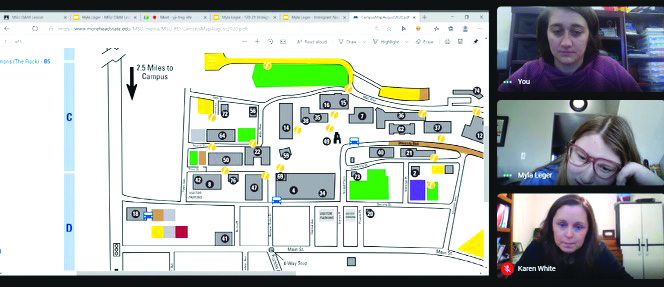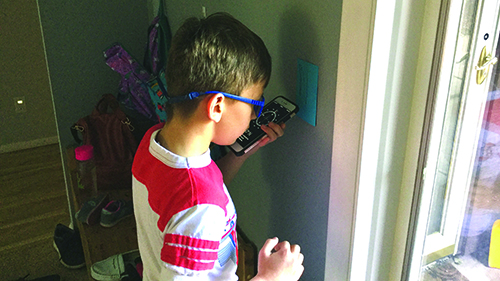For O&M, being limited to online instruction has made meeting goals of learning street crossing, getting transit, and practicing travel in general difficult to execute even by simulating virtual reality via computer. There is nothing like standing on the street corner and analyzing traffic patterns live. Also, parents are not taking kids to the stores or out on outings anymore due to valid health concerns, but this is also limiting their ability to learn through experiences and isolating the child even more. —Native American of Hispanic descent, dually certified professional
Eleven (61%) of the preschool students and 107 (67%) of the school-age students were being served by an O&M specialist at the time the family members completed the survey. One preschooler (6%) and 35 (22%) school-age students were not receiving O&M services as part of their educational program; 18 (11%) family members of school-age students reported the O&M specialist had offered services which their family declined. There was one (6%) family member of a preschooler whose child had O&M services on their IEP; however, the family member had not been contacted by the O&M specialist.
Family members of preschool and school-age children were asked how the O&M specialist had supported them since the 2020-2021 school year began. There were 116 family members who reported one or more ways the O&M specialist supported them with an average of 2.63 (SD=1.59) ways, including:
Meeting with them and/or their child in person in the same physical space (n=74)
Calling or texting (n=62)
Meeting online with their child (n=59)
Emailing ideas and activities (n=44)
Mailing or delivering toys or materials to the home (n=28)
Recommending resources specific to children with visual impairments (n=21)
Speaking by telephone or online to demonstrate or describe specific ways to support the child’s learning (n=21)
Making and sharing videos online to demonstrate things specific to the child (n=11)
[Online instruction from the O&M specialists] is definitely better than nothing but I worry about him getting behind or skills getting rusty because his O&M [specialist] can’t be here in person to instruct him. It seems with what we know about COVID that it should be safe to work with him from a distance if everyone is masked and it is outside. —White female family member of a child who is blind, 5 to 7 years old
From a list of 25 options, 157 O&M specialists selected the multiple ways they provided instruction with an average of 9.15 (SD=5.79) ways selected. The 12 most frequent ways the O&M specialists provided instruction included:
Consulting with other educational team members about students’ O&M skills (n=111)
Providing in-person instruction in the same physical space (n=107)
Meeting online with the student and family member to consult, give suggestions, etc. (n=94)
Texting with the student and/or their family members to consult, give suggestions, etc. (n=84)
Sending resources to students and/or their family members (n=78)
Teaching other ECC content that is still relevant to O&M (n=76)
Speaking by telephone with students and/or their family members to consult, give suggestions, etc. (n=75)
Providing suggestions on how to practice O&M skills in familiar environments (n=74)
Creating assignments for students to complete based on students’ IEP goals (n=72)
Sharing with family members ideas for the child to practice concepts (n=65)
Sending family members videos to watch with their child (n=64)
Exploring websites with the student to learn about communities (n=60)
The O&M specialists reported how they were conducting assessments with their students. Sixty-one O&M specialists collected assessment data in person, while 44 O&M specialists completed the assessment online. Nineteen O&M specialists reported they were not conducting O&M assessments, and 31 indicated that though they were not conducting O&M assessments at the time they completed the survey, they planned to start doing so in the future.
Teaching Students a Variety Of O&M Skills
It has been difficult to maintain 6 feet when hand-under-hand modeling is necessary or physical prompts are required. More verbal prompting has been a personal challenge. Constantly finding myself saying ’How do I say this so that the kid understands?’ Also, I am encouraging lots of independent movement with my elementary kiddos and not allowing human guide technique. It has actually been fantastic because my student is learning landmarks and clues and routes by himself. —White female O&M specialist
There were 116 (71%) of 164 O&M specialists serving students in early intervention, preschool, and/or serving students with additional disabilities. Twenty-five O&M specialists were working in the same physical space with children in early interven- tion, 35 with preschoolers, and 63 with those who have additional disabilities. Eighty-six O&M specialists were providing consultation to other educational team members. The O&M specialists selected multiple ways they were supporting family members in building their child’s O&M skills, including:
Supporting family members in creating safe environments for the child to explore (n=63)
Suggesting terms/language the family members should use (n=60)
Encouraging family members to point out auditory sounds to the child (n=58)
Suggesting ways to get the child to explore the environment (n=58)
Helping to build the child’s sound localization skills (n=55)
Recommending the family member use descriptive language (n=53)
Providing instruction in other ECC content related to O&M skills (n=52)
When asked if they had students with IEP goals focused on school campus travel, 116 (71%) of 164 O&M specialists reported they did. Seventy-seven O&M specialists were working in the same physical space with their students and 57 O&M specialists were providing consultation to other educational team members. The O&M specialists selected multiple ways they were working with their students and/or their students’ family members to address school campus travel goals. They were:
Providing instruction in other ECC content related to O&M skills (n=53)
Providing ideas for students and family members to practice skills in familiar environments (n=49)
Having students create maps of the school or route (n=45)
Designing opportunities for students to practice problem-solving skills (n=40)
Students who had IEP goals focused on neighborhood/residential travel were on the caseloads of 116 O&M specialists. Seventy-four O&M specialists were working on residential travel goals with their students in person and 44 O&M specialists were providing consultation to other educational team members about their students’ travel skills. With their students who had residential travel IEP goals, the O&M specialists were:
Providing instruction in other ECC content related to O&M skills (n=55)
Supporting family members in having the student practice O&M skills in familiar environments (n=47)
Having students create maps of neighborhoods (n=44)
Sharing ideas with family members and students to practice problem-solving and orientation skills in familiar environments (n=37)
Suggesting ways for family members to practice concepts with the student such as “block” or “curb” (n=37)
There were 81 O&M specialists who had students with IEP goals focused on business/commercial travel. Fifty-four O&M specialists were working with students with these goals in person, and 28 O&M specialists were providing consultation to educational team members. O&M specialists were:
Having students plan routes in business areas (n=48)
Providing instruction in other ECC content related to O&M skills (n=28)
Having students use online tools (e.g., Google Maps) to analyze intersections (n=36)
Having students plan routes in future environments such as the community where they planned to attend college (n=36)
Having students create maps of commercial areas (n=22)
Seventy-two O&M specialists had students with IEP goals focused on use of public transit, rideshare services, and/or exploring driving with low vision. Only 16 of the O&M specialists were working in person with students on these goals and 15 were consulting with other educational team members about students’ O&M skills. Thus, most of the students with these travel goals were missing out on learning opportunities due to pandemic restrictions. Especially for students nearing graduation or aging out of special education services, the time missed because of the pandemic can have life-long impact. The most frequent ways O&M specialists were addressing these goals were:
Having students plan hypothetical trips (n=50)
Providing instruction in other ECC content related to O&M skills (n=42)
Having students compare the cost of different transit options for the same route (n=35)
Gathering information about paratransit to determine if they qualify (n=31)
Having students locate maps of bus stations, train stations, etc. and using these when role-playing different scenarios (n=27).
I have not been able to conduct in-person O&M assessments this school year. I have a student who completed her in-school travel goal. Her annual IEP in early November includes a new goal pertaining to residential area travel skills and concepts. I have not seen her in person since March. I did not have baseline [data] so I included a more general IEP goal. [I am] using pictures, worksheets, and Google Maps to begin instruction. —White female O&M specialist
Assessment
Conducting assessments and using the information to inform O&M specialists of the skills students need to learn has been challenging to do for many O&M specialists whether in person or online. With in-person assessments, the necessity to social distance and the use of masks has presented challenges with communication and monitoring. Many families are reluctant to have their child in close proximity to the O&M specialist due to safety concerns, and there are also O&M specialists who do not want to be in close proximity to students. Limited travel opportunities in the community have made assessing bus skills, locating and entering businesses, and other higher-level skills a challenge.
O&M specialists reported that when they were working online with family members to assess students’ O&M skills, they had to be explicit with directions, spend time coaching family members, and send materials ahead of time to the family. Taking time to do these things took away from instructional time. On the other hand, because some family members were involved in the assessment process, they were learning about their child’s skills and those that their child needed to develop.

